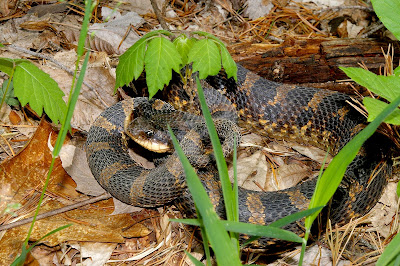Over the weekend I was treated to the most amazing display of defense behaviors I have ever witnessed. This is nature at its finest.
I was on a hike in Ohio with some amazing naturalists, John Howard and Martin McCallister, during the Flora-Quest conference. Our group of about twelve stumbled across a huge, gorgeous, Hognose Snake. Hognose snakes are completely harmless and get their name from their upturned nose that they use to find their favorite food, toads, by rooting under the leaves on the forest floor. The snake has a pair of sharp teeth in the back of its mouth that can "pop" the toad when it has inflated with air as its defense mechanism. Talk about specialization! Even though they are harmless, they do not want to be messed with and put on a series of bluffing reactions to make a predator leave it alone.
First the snake will fill up with air and flatten its head. It then repeatedly releases the air to make very loud hissing noises that would make a predator think twice. If one is brave enough to touch the snake during this display, which John Howard did, the snake will quickly strike. But no worries, it rarely opens its mouth during the strike. It is part of the bluff. This snake wants the predator to think he is a big, bad snake that shouldn't be bothered. If the predator persists, the snakes next defense is releasing a foul-smelling musk. Most animals will retreat after this.

Hognose snake playing dead. Note the tongue on the left side of its head. Photo by John Howard.
If the predator still will not leave the snake alone, its last resort is to play dead. It will act as if someone has chopped its head off and convulse and writh around on the ground, simultaneously vomitting its stomach contents. Finally, it will lay on its back completely still, with its tongue protruding out of its mouth. It wants to be so convincing, that if you flip it over on its belly, it will quickly flip back to the dead position.
The Eastern Hognose is common to Indiana and can be found in woodlands in and around Indianapolis. Hopefully, you too will be fortunate enough to encounter this wonderful animal.

No comments:
Post a Comment